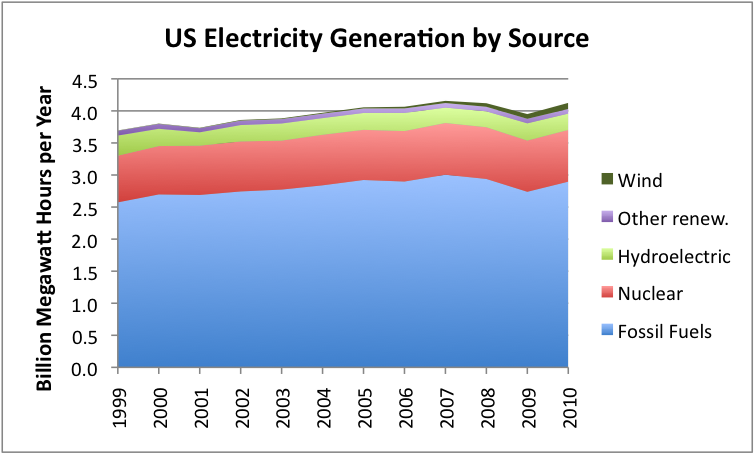Obstacles Facing US Wind Energy Posted by Gail the Actuary at The Oil Drum:
In the United States, we have been working on scaling up wind energy but not getting very far. In 2010, wind energy supplied only 2.3% of electricity purchased.

Such slow progress seems strange for a product that seems to have such great promise. It can reduce CO2 emissions. It doesn’t require fuel. It is at least partly US made. It seems to have promise for protecting against rising fossil fuel prices.
In this post, I discuss a few of the obstacles facing wind energy in the United States and their implications for the expansion of wind energy.
Obstacle 1: Wind energy is dependent on large subsidies.
According to the EIA’s report, Direct Federal Financial Interventions and Subsidies in Energy in Fiscal Year 2010, wind energy received subsidies of $4.986 billion from the federal government for Fiscal Year 2010. This amount is equal to approximately half the cost of new wind power installed during that period. State and local subsidies would be in addition. (The US Wind Energy Association shows that 6034 megawatts of new capacity was installed between October 1, 2009 and September 30, 2010, so the subsidy per megawatt was $826,318. This compares to an average cost per megawatt of about $1.4 million, excluding construction and connection costs.)
Wind energy’s largest subsidy, the Production Tax Credit, is set to expire on December 31, 2012, unless Congress acts to extend it, so there is now a big rush to get orders filled before that date. A study by Navigant Consultingforecasts a large drop in wind investment, if the Production Tax Credit is not extended (Figure 2).

Needless to say, the US Federal Government is not flush with money for subsidies, so there is the possibility that subsidies will not be renewed or will be cut back.
Obstacle 2: Wind energy is more variable than electricity produced by fossil fuels and by nuclear energy.
Wind blows when it chooses, which is often not when it is needed most. In theory, this problem could be resolved with robust long-distance transmission of electricity and with adequate electrical storage, but in the US, these are not available. Bill Richardson, energy secretary under Bill Clinton has said, “We’re a superpower with a Third World grid.” This means that even in locations where wind energy makes up a relatively large share of the fuel mix, other types of generations must be available to supply almost the full level of demand, if the wind is not blowing.
As a result, the role of wind energy is fairly limited. What wind energy does is permit electricity generating plants, particularly those fueled by natural gas, touse less fuel. Consequently, the price of wind energy tends to compete with the price of fuel, rather than with the wholesale price of electricity.